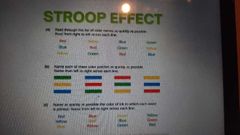![]()
![]()
![]()
Use LEFT and RIGHT arrow keys to navigate between flashcards;
Use UP and DOWN arrow keys to flip the card;
H to show hint;
A reads text to speech;
38 Cards in this Set
- Front
- Back
|
Attention |
Selected process of limited amount of information from all of the information captured by our senses, our stored memories, and our other cognitive processes |
|
|
Consciousness |
Both the feeling of awareness and te content of awareness, some of which may be under the focus of attention Napupunta sa unconscious pag di ginagamit actively, pag natrigger, you can retrieve |
|
|
Signal Detection and Vigilance Search Selective Attention Divided Attention |
4 Functions of Attention |
|
|
Signal Detention and Vigilance |
Detect the appearance of a particular stimulus Required to detect a particular stimulus Ex: life guard |
|
|
Search |
Engage in an active search for particular stimuli Looking for something ~ Ex: Searching a missing pencil |
|
|
Selective Attention |
We choose where we focus our attention and ignore the background noise Choose to attend to some stimuli amd ignore others |
|
|
Divided Attention |
Multitasking Engage in more than one task at a time |
|
|
Signal-Detection |
Detection of stimulus Detection of the appearance of a particular stimulus |
|
|
Vigilance |
Person's ability to attend to a field of a stimulation over a prolonged period Ability to pay attention in extended period of time Pagiging matalas |
|
|
Signal Detection Theory |
Explain how people pick out important stimuli embedder in a wealth of irrelevant distracting stimuli "Signal"- the stimuli |
|
|
Hits(true positive) False alarm (false positive) Misses (false negative) Correct rejection (true negative) |
Four Possible Outcomes of Signal-Detection Theory |
|
|
Hits |
True positive, you detect a signal and may signal talaga in reality |
|
|
False alarm |
False positive, may nadetect na signal but wala in reality |
|
|
Misses |
False negative, walang nadetect na signal pero meron, failed to detect the signal |
|
|
Correct rejection |
True negative, walang signal kaya walang nadetect, correctly identifies na walang signal |
|
|
Search |
Refers to a scan of te environment for particular features —actively looking for something when you are not sure where it will appear |
|
|
Distracters |
Nontarget stimuli that divert our attention away from the target stimulusPangguloEx: Items na may katulad/similar features sa hinahanap |
|
|
Feature search Conjunction search |
2 Kinds of Searches |
|
|
Feature search |
Look for just one feature of the object |
|
|
Conjunction search |
Combine two or more features of the object |
|
|
Cocktail Party Problem |
The process of tracking one conversation while distracted by other conversations |
|
|
Colin Cherry |
Who's the proponent of Cocktail Party Problem? |
|
|
Shadowing |
A task or experiment wherein the participants will listen to 2 different messages at the same time using headphones |
|
|
Attended Input |
Where we allocate our attention with other stimuli |
|
|
Unattended Input |
The stimuli you chose to ignore |
|
|
Dichotic Presentation |
Physical and Sensory changes are noticed in unattended Input but semantic changes are not. Kapag nabanggit ang name, pwedeng magshift ang unattended as attended |
|
|
Anxiety |
A factor that can affect our attention Being anxious. Trait based - part of our traits, clinically diagnosed State based - situation based, ex: presenting in front |
|
|
Arousal |
A factor that can affect our attention Ex: tired, drowsy |
|
|
Task Difficulty |
A factor that can affect our attention If a task is difficult, you might require more attention than easy ones |
|
|
Skill |
A factor that can affect our attention Enhanced attention accompanies greater skill mastery |
|
|
ADHD |
Difficulty with attention Has three primary symptoms: Inattention, Hyperactivity, Impulsiveness |
|
|
Change Bilndness |
Inability to detect changes in objects or scenes that are being viewed |
|
|
Inattentional Blindness |
Phenomenon in which people are not able to see things that are actually there |
|
|
Spatial Neglect |
also called Hemineglect Participant ignore the half of their visual field that is contralateral to the hemisphere of the brain that has lesion Ex: Left-side Neglect -walang vision sa left side, kulang ang information received sa left na part |
|
|
Automatic Processes |
Perform without conscious awareness. They demand little to no effort or even intention. Sanay na sanay na, accustomed na na gawin kahit di na isipin |
|
|
Controlled Processes |
Requires more attention Accessible to conscious control and even requirebit, performed serially |
|
|
Automatization |
Controlled processes eventually become automatic ones as a result of practice |
|

Stropp Effect |
Difficulty in selectively attending to color of the ink and trying to ignore the word that is printed with the ink of that color |

